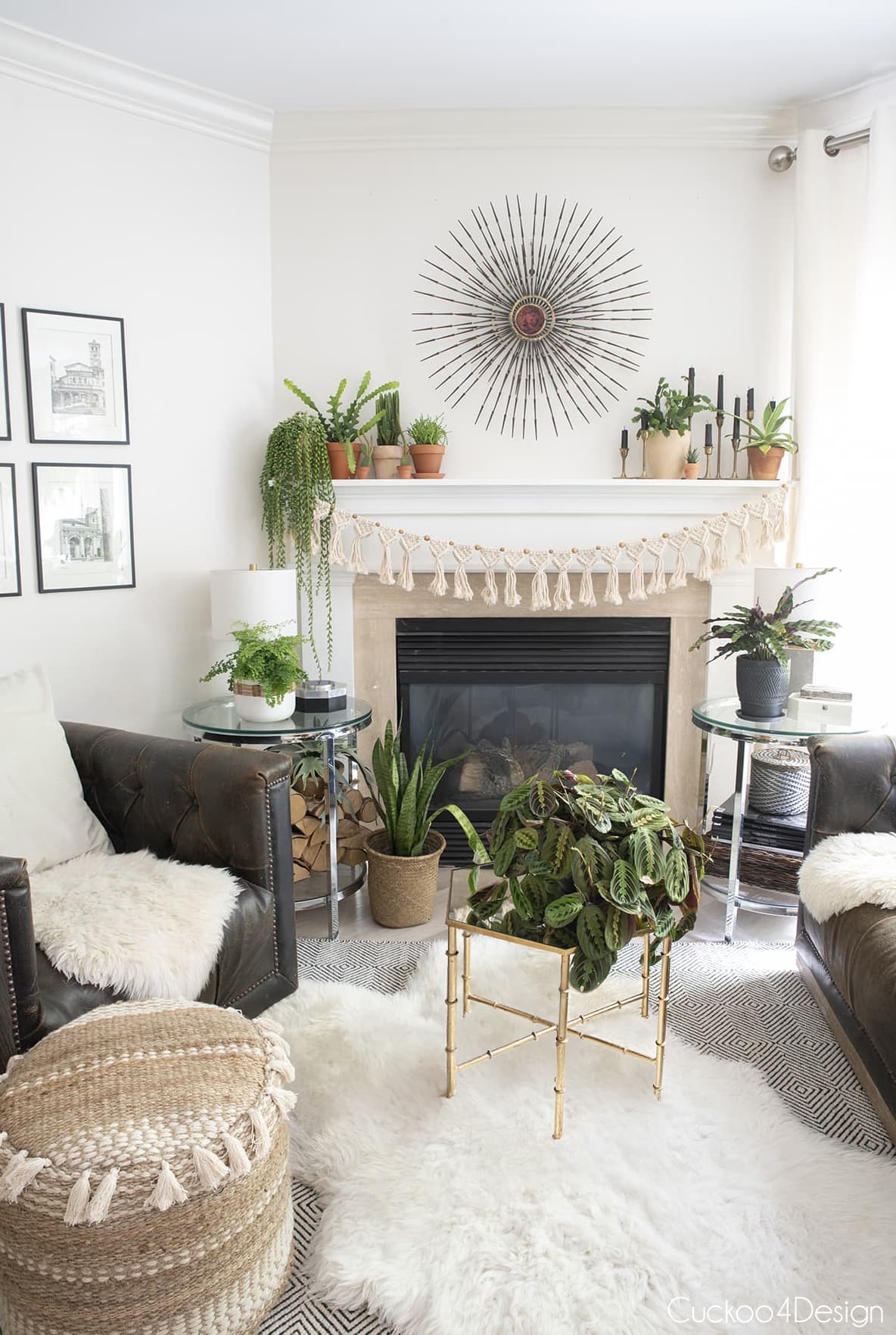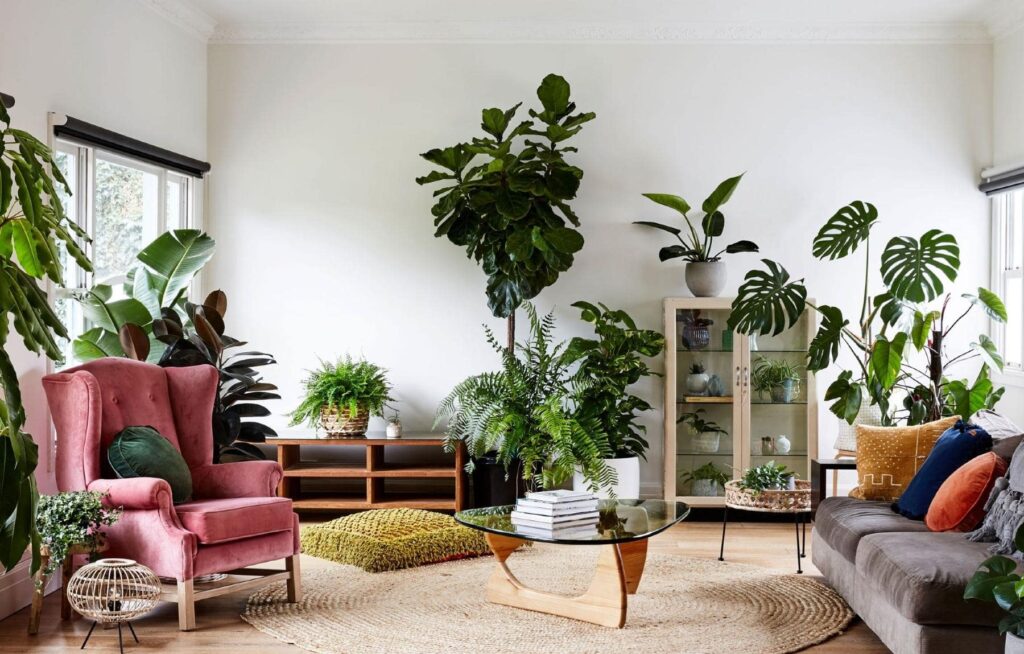Plants bring life to any living room. They add color and fresh air.
Decorating your living room with plants is both fun and rewarding. It makes your space feel more welcoming. Plants can transform a dull room into a vibrant oasis. Imagine coming home to a living room filled with lush greenery. It can reduce stress and boost your mood.
Plus, plants are great conversation starters. Whether you have a small apartment or a large house, plants fit any space. They come in all shapes and sizes, so you can find the perfect one for your room. Get ready to explore how plants can change your living room. Let’s dive into the world of indoor plants and home decoration!

Credit: www.pinterest.com
Choosing The Right Plants
Decorating your living room with plants brings fresh air and vibrant energy. But choosing the right plants is key. Different plants thrive in different conditions. Selecting the right ones ensures they grow well. Here, we explore the best choices for your living room.
Low Light Options
Not all living rooms get ample sunlight. For such spaces, low light plants are perfect. Snake plants are a top choice. They need minimal sunlight. Another great option is the ZZ plant. It grows well in low light and is easy to maintain.
Pothos is also ideal. It adapts to various light conditions. Its trailing vines add beauty. Philodendrons are versatile too. They can thrive in dimly lit corners. These plants enhance your living space without needing much light.
Pet-friendly Choices
Pet owners need to be cautious. Some plants are toxic to pets. Opt for pet-friendly plants to keep your furry friends safe. Spider plants are non-toxic and attractive. They purify the air and are safe for pets.
Areca palms are another safe option. They add a tropical feel. Boston ferns are pet-friendly too. Their lush fronds make your living room lively. Calatheas are a good choice as well. They are safe and have unique patterns.
These plants ensure a beautiful and safe environment for both you and your pets.
:max_bytes(150000):strip_icc()/how-to-arrange-plants-in-a-living-room-6739917-hero-b77d7a7ce4a54e90b13b9267935a7d12.jpg)
Credit: www.thespruce.com
Plant Placement Ideas
Decorating your living room with plants can bring life and freshness. The key to a beautiful plant-filled space is strategic placement. Proper plant placement can transform your living room into a green oasis. Let’s explore some ideas for placing plants in your living room.
Corners And Nooks
Corners and nooks are often overlooked. These spaces can be perfect for plants. A tall plant in a corner can create a focal point. It adds height and visual interest. Consider using plants like fiddle leaf figs or snake plants. These plants thrive in low-light conditions. They require minimal care, making them ideal for corners.
Nooks can house smaller plants. Use shelves or small tables to elevate them. This adds layers and depth to the room. Think about using succulents or small ferns. They fit well in tight spaces and need little maintenance.
Hanging Plants
Hanging plants add a unique charm to any living room. They save floor space and draw the eye upwards. This can make the room feel larger. Use macramé hangers or wall-mounted planters for a stylish touch.
Choose plants like pothos or spider plants for hanging. These plants have trailing vines that look beautiful cascading down. They are also easy to care for. Place hanging plants near windows for optimal light. They thrive in natural light and add a fresh look to the space.
Combining Plants With Furniture
Bringing plants into your living room can transform the space. They add life and color. When combined with furniture, plants create a cohesive look. Here are some ideas to combine plants with furniture effectively.
Shelves And Racks
Shelves and racks are perfect for displaying plants. They maximize vertical space. Here are some tips:
- Choose sturdy shelves to hold plant pots.
- Mix different plant sizes for a balanced look.
- Use hanging racks for trailing plants.
- Add books or ornaments to create layers.
Consider a table to display your plants. It can be a great focal point.
Coffee Tables
Coffee tables can host small plants. They bring nature close. Here are some ideas:
- Place a small succulent in the center.
- Use a tray to group several small plants.
- Combine with a candle or small sculpture.
- Keep it simple to avoid clutter.
Remember, balance is key. Too many plants can overwhelm the space.
| Furniture | Plant Type | Placement Tips |
|---|---|---|
| Shelves | Trailing Plants | Use hanging racks |
| Racks | Mixed Sizes | Layer with books |
| Coffee Tables | Succulents | Group with a tray |
Combining plants with furniture requires some planning. But the result is worth it. Your living room will feel more vibrant and welcoming.
Creating A Focal Point
Creating a focal point in your living room enhances its visual appeal. Plants are a great way to achieve this. They bring life and color to your space. A well-chosen plant can draw attention and create a stunning centerpiece. Here are some ideas to help you create a focal point with plants.
Statement Plants
Statement plants are large and eye-catching. They can stand alone and capture attention. Consider these options:
- Fiddle Leaf Fig: Known for its large, glossy leaves.
- Monstera Deliciosa: Features unique, split leaves.
- Bird of Paradise: Offers tall, striking foliage.
Place statement plants in prominent spots. Corners or near windows work best. Ensure they receive enough light. These plants need space to grow and thrive. They can transform any living room into a green oasis.
Plant Clusters
Plant clusters add depth and variety. Grouping small plants together creates interest. Follow these steps to create effective clusters:
- Choose plants of different heights and textures.
- Combine pots in various sizes and colors.
- Place taller plants at the back, smaller ones in front.
Examples of plants for clusters:
- Snake Plant: Tall, upright leaves.
- Succulents: Small and easy to care for.
- Pothos: Trailing vines add a cascading effect.
Plant clusters work well on tables or shelves. They can also complement your statement plant. Experiment with different arrangements. Find the combination that suits your style.
Incorporating Plant Stands
Incorporating plant stands can elevate your living room decor. They add height, dimension, and style. Plant stands come in various materials, each bringing a unique charm. Let’s explore two popular types: wooden stands and metal stands.
Wooden Stands
Wooden plant stands offer a natural and warm look. They blend well with almost any interior style. Choose from different wood types like oak, pine, or bamboo. Each type has its own texture and color. Wooden stands are sturdy and durable. They can hold heavy plants without wobbling. Consider a tiered wooden stand for multiple plants. This will save space and create a beautiful display.
Metal Stands
Metal plant stands bring a modern and sleek feel. They often come in black, white, or metallic finishes. These stands are perfect for contemporary or industrial decor. Metal stands are lightweight yet strong. They can support large plants easily. Look for geometric designs to add an artistic touch. Some metal stands come with intricate patterns. These can serve as a focal point in your living room.

Credit: cuckoo4design.com
Maintaining Indoor Plants
Decorating your living room with plants adds life and color to your space. But, maintaining indoor plants requires proper care. This section will guide you on how to keep your indoor plants healthy and vibrant. We will cover essential tips on watering, pruning, and cleaning.
Watering Tips
Proper watering is crucial for the health of your indoor plants. Here are some tips to ensure your plants get the right amount of water:
- Check soil moisture: Always check the soil before watering. Insert your finger about an inch into the soil. If it feels dry, it’s time to water.
- Watering schedule: Water your plants in the morning. This allows them to absorb moisture before the heat of the day.
- Drainage: Ensure your pots have drainage holes. This prevents water from accumulating at the bottom and causing root rot.
Pruning And Cleaning
Pruning and cleaning your plants help them stay healthy and look their best. Follow these steps for effective plant maintenance:
- Remove dead leaves: Trim away any dead or yellowing leaves. This encourages new growth and keeps the plant looking tidy.
- Trim overgrown branches: Cut back any branches that are too long or misshapen. Use clean, sharp scissors to avoid damaging the plant.
- Dust the leaves: Gently wipe the leaves with a damp cloth. This removes dust and allows the plant to breathe better.
Regular pruning and cleaning ensure your plants remain healthy and enhance your living room’s decor.
Seasonal Plant Rotation
Decorating your living room with plants can bring life and freshness to your home. One way to keep your space dynamic and interesting is through seasonal plant rotation. Changing plants with the seasons can help keep your living room vibrant and healthy all year round.
Spring And Summer
Spring and summer are ideal for bright, flowering plants. During these seasons, consider adding plants like begonias, geraniums, or orchids. These plants thrive in the warmer weather and will add bursts of color to your living room. Also, succulents and cacti can be great options. They need less water and can handle the increased sunlight of the season.
In summer, you might want to introduce herbs like basil or mint. They not only add greenery but also provide fresh flavors for your cooking. Ensure they get plenty of light and water them regularly. Rotating these seasonal plants keeps your living room fresh and lively.
Fall And Winter
As the weather cools, it’s time to switch to plants that thrive in lower light and cooler temperatures. Consider adding evergreens like ferns or ivy. These plants can handle the reduced sunlight and still add a touch of green to your space. Also, think about adding some festive plants like poinsettias for the holiday season.
Winter is a great time for indoor plants like snake plants or ZZ plants. These hardy plants can survive with less light and are low-maintenance. They help purify the air, making your living room cozy and inviting during the colder months. Regularly rotating your plants with the seasons ensures your living room remains a vibrant and welcoming space all year round.
Enhancing Aesthetics With Pots
Decorating your living room with plants can bring life and freshness. But the magic doesn’t stop there. The pots you choose for your plants can enhance the room’s aesthetics. They are not just containers; they are pieces of art. Let’s explore how colorful pots and decorative planters can elevate your living space.
Colorful Pots
Colorful pots can add vibrancy and character. They can match your room’s theme or stand out as accent pieces. Bright colors can lift the mood and create a lively environment. Soft, pastel colors can provide a calming effect. Mixing and matching different colors can create a playful and dynamic look. Don’t be afraid to experiment with bold colors to make a statement.
Decorative Planters
Decorative planters come in various designs, from sleek modern to rustic charm. They can be made of different materials like ceramic, metal, or wood. Each material adds a unique texture and feel to your room. Planters with intricate patterns can serve as artistic pieces. They draw attention and become conversation starters. Hanging planters can save space and create a vertical garden effect. This can make your living room look lush and green.
Frequently Asked Questions
What Are The Best Plants For A Living Room?
The best plants for a living room include snake plants, pothos, fiddle leaf figs, and peace lilies. These plants are easy to care for and improve air quality. They also add a touch of greenery and freshness to your living space.
How Do Indoor Plants Improve Air Quality?
Indoor plants improve air quality by absorbing toxins and releasing oxygen. They reduce pollutants like formaldehyde and benzene. This leads to a healthier and more breathable living environment. Additionally, plants can increase humidity, which is beneficial for the skin and respiratory system.
How To Arrange Plants In A Small Living Room?
In a small living room, use vertical space for plants. Hanging planters, wall-mounted shelves, and tall plant stands work well. Choose smaller plants for tabletops and corners. Grouping plants of different heights creates a dynamic and visually appealing arrangement.
How Often Should I Water My Indoor Plants?
Watering frequency depends on the plant type and environmental conditions. Generally, water most indoor plants once a week. Check the soil moisture before watering. Overwatering can harm plants. Adjust watering based on the season and plant needs.
Conclusion
Bringing plants into your living room creates a refreshing and cozy atmosphere. They add life, color, and warmth. Plants also improve air quality and reduce stress. Choose varieties that fit your space and light conditions. Arrange them thoughtfully to enhance your room’s aesthetics.
Small plants on shelves, larger ones in corners. Mixing sizes and types adds visual interest. Enjoy the natural beauty and health benefits plants provide. Your living room will become a vibrant, inviting space for family and friends. Start decorating with plants today and transform your home.

Sarah Bennett is a passionate home decor enthusiast and the creative mind behind ConsumerDecor. With a love for design and an eye for detail, she shares inspiring ideas, emerging trends, and practical tips to help readers create beautiful, functional living spaces. Sarah believes that every home deserves a touch of style, no matter the budget.





